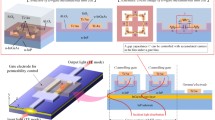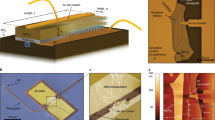Abstract
In this work, a novel design of an electro-tunable narrow channel based on an anisotropic epsilon-near-zero metamaterial is presented. The ENZ condition can be flexibly tuned by an applied gate voltage. This permittivity-tunable channel is composed of periodic alternating layers of graphene and nanoglass with a thickness of 3 nm. Additionally, a dual output light modulator is utilized to expand its application. Numerical analysis results show that the maximum transmittance of the incident light can reach 96.7%, and the extinction ratio of the device is 14.8 dB when the gate voltage is added to 4.96 V at the near-infrared wavelength. This ultracompact optical device may open a new realm in highly integrated photonic circuits, especially on the nano-chips.





Similar content being viewed by others
Availability of data and materials
The data sets used or analyzed during the current study are available from the corresponding author on reasonable request.
Code availability
Not applicable.
References
Askari, M., Hosseini, M.V.: A novel metamaterial design for achieving a large group index via classical electromagnetically induced reflectance. Opt. Quantum Electron. 52(4) (2020)
Chen, J., Zhi, L., Song, Y., et al.: Hybrid long-range surface plasmon-polariton modes with tight field confinement guided by asymmetrical waveguides. Opt. Express 17(26), 23603–23609 (2009)
Danilov, D., Hahn, H., Gleiter, H., et al.: Mechanisms of nanoglass ultrastability. ACS Nano 10(3), 3241–3247 (2016)
Denard, RH.: Design of ion-implanted MOSFETs with very small physical dimensions. IEEE J. Solid-State Circuits (1974)
Ding, K., Shen, Y., Ng, J., et al.: Equivalent-medium theory for metamaterials made by planar electronic materials. EPL 102(2), 28005 (2013)
Edwards, B., Alu, A., Young, M.E., Silveirinha, M., Engheta, N.: Experimental verification of epsilon-near-zero metamaterial coupling and energy squeezing using a microwave waveguide. Phys. Rev. Lett. 100, 033903 (2008)
Efazat, S.S., Basiri, R., Jam, S.: Optimization based design of a wideband near zero refractive index metasurface for gain improvement of planar antennas in the terahertz band. Opt. Quantum Electron. 52(12) (2020)
Efetov, D.K., Kim, P.: Controlling electron-phonon interactions in graphene at ultrahigh carrier densities. Phys. Rev. Lett. 105(25), 256805 (2010)
Emadi, R., Safian, R., Nezhad, A.Z.: Plasmonic cloaking for irregular inclusions using an epsilon-near-zero region composed of a graphene–silica stack. J. Opt. Soc. Am. B 35(3), 643 (2018)
Falkovsky, L.A.: Optical properties of graphene. J. Phys. Conf. Ser. 129, 012004 (2008)
Gric, T., Hess, O.: Tunable surface waves at the interface separating different graphene-dielectric composite hyperbolic metamaterials. Opt. Express 25(10), 11466 (2017)
Gric, T., Hess, O. et al.: Surface plasmon polaritons at the interface of two nanowire metamaterials. J. Opt. 19(8) (2017)
Gric, T., Hess, O., et al.: Surface waves supported by the nanostructured semiconductor metamaterials. J. Electromagn. Waves Appl. 2018.
Huang, Y., Li, J.: Total reflection and cloaking by triangular defects embedded in zero-index metamaterials. Adv. Appl. Math. Mech. 7, 135–144 (2015)
Hui, F.M., Jin, H.S., Wei, X.J., et al.: Experimental realization of bending waveguide using anisotropic zero-index materials. Appl. Phys. Lett. 101(25), 3966 (2012)
Ioannidis, T., Gric, T., Rafailov, E.: Surface plasmon polariton waves propagation at the boundary of graphene-based metamaterial and corrugated metal in THz range. Opt. Quantum Electron. 52(1), 10.1–10.12 (2020)
Kim, N.S., Austin, T., Baauw, D., et al.: Leakage current: Moore’s law meets static power. Computer 36(12), 68–75 (2003)
Klimchitskaya, G.L., Mostepanenko, V.M.: Conductivity of pure graphene: theoretical approach using the polarization tensor. Phys. Rev. B, Condens. Matter Mater. Phys. (2016)
Kundtz, N., Smith, D.R.: Extreme-angle broadband metamaterial lens. Nat. Mater. 9, 129–132 (2010)
Li, Z., Guo, Z., Li, X., et al. Graphene light modulator based on dual-ring resonator structure. Opt. Quantum Electron. 52(6) (2020)
Lu, Z.: Nanoscale electro-optic modulators based on graphene-slot. J. Opt. Soc. Am. B 29(6), 1490–1496 (2012)
Maas, R., Parsons, J., Engheta, N., Polman, A.: Experimental realization of an epsilon-near-zero metamaterial at visible wavelengths. Nat. Photon. 7, 907–912 (2013)
Nair, R.R., Blake, P., Grigorenko, A.N., et al.: Fine structure constant defines visual transparency of graphene. Science 320(5881), 1308–1308 (2008)
Niu, X., Hu, X., Chu, S., et al. Epsilon-near-zero photonics: a new platform for integrated devices. Adv. Opt. Mater. 1701292 (2018)
Ourir, A., Maurel, A., Pagneux, V.: Tunneling of electromagnetic energy in multiple connected leads using -near-zero materials. Opt. Lett. 38(12), 2092–2094 (2013)
Papasimakis, N., Thongrattanasiri, S., Zheludev, N.I., et al.: The magnetic response of graphene split-ring metamaterials. Light Sci. Appl. 2(7), e78 (2013)
Pendry, J.B.: Negative refraction makes a perfect lens. Phys. Rev. Lett. 85(18), 3966–3969 (2000)
Pham, T.A., Li, T., Shankar, S., Gygi, F., Galli, G.: First-principles investigations of the dielectric properties of crystalline and amorphous Si3N4 thin films. Appl. Phys. Lett. 96(6), 25 (2010)
Reynard, J.P., Verove, C., Sabouret, E., et al.: Integration of fluorine-doped silicon oxide in copper pilot line for 012-μm technology. Microelectron. Eng. 60(1), 113–118 (2002)
Shen, A., et al.: Proposal for an optical switch based on graphene-silicon-waveguide microring. IEEE Photonics Technol. Lett. (2014).
Silveirinha, M.G., Engheta, N.: Theory of supercoupling, squeezing wave energy, and field confinement in narrow channels and tight bends using e near-zero metamaterials. Phys. Rev. B Condens. Matter Mater. Phys. 76(24): 2451091–24510917 (2007)
Silveirinha, M., Engheta, N.: Tunneling of electromagnetic energy through subwavelength channels and bends using epsilon-near-zero materials. Phys. Rev. Lett. 97(15), 157403 (2006)
Smith, D.R, Pendry, J.B., et al.: Metamaterials and negative refractive index. Science (2004)
Soto, W.G., Soto, A.I. Controlling the extinction ratio in optical networks. US (2005)
Stauber, T., Peres, N., Geim, A.: Optical conductivity of graphene in the visible region of the spectrum. Phys. Rev. B 78(8) (2008)
Wu, Y., Li, J.: Total reflection and cloaking by zero-index metamaterials loaded with rectangular dielectric defects. Appl. Phys. Lett. 101, 4184 (2013)
Wu, K., Meng, Y., Xu, J., et al.: Novel Fe-based nanoglass as efficient noble-metal-free electrocatalyst for alkaline hydrogen evolution reaction. Scripta Mater. 188, 135–139 (2020)
Xiao, Y.H., Rui, L.: Comparison of graphene-based transverse magnetic and electric surface plasmon modes. IEEE J. Sel. Top. Quantum Electron. 20(1), 62–67 (2013)
Xu, Y., Chen, H.: Total reflection and transmission by epsilon-near-zero metamaterials with defects. Appl. Phys. Lett. 98, 113501 (2011)
Xu, Z., Zhu, J., Xu, W., et al.: Novel graphene enhancement nanolaser based on hybrid plasmonic waveguides at optical communication wavelength. Chin. Phys. B 27(08), 46–51 (2018)
Yang, L., Pei, C., Ao, S., et al.: Ultracompact plasmonic switch based on graphene-silica metamaterial. Appl. Phys. Lett. 104(21), 157403 (2014)
Yang, L., Hu, T., Shen, A., et al.: Ultracompact optical modulator based on graphene-silica metamaterial. Opt. Lett. 39(7), 1909–1912 (2014b)
Zhu, B., Ren, G., Zheng, S., et al.: Nanoscale dielectric-graphene-dielectric tunable infrared waveguide with ultrahigh refractive indices. Opt. Express 21(14), 17089–17096 (2013)
Funding
This work was supported by the Natural Science Foundation of Hebei Province grant (No: F2017203316) in China, the Youth Fund Project of Hebei Provincial Department of Education (No: QN2019061) in China.
Author information
Authors and Affiliations
Contributions
Zhibin Wang, Qiufan Cheng, Xin Li contributed to the conception of the study; Zhibin Wang, Qiufan Cheng, Zhiquan Li contributed to analysis and manuscript preparation; Qiufan Cheng and Shuhan Meng performed the data analyses and wrote the manuscript.
Corresponding author
Ethics declarations
Conflict of interest
The authors declared that they have no conflicts of interest in this work.
Ethics approval
Not applicable.
Consent to participate
Informed consent was obtained from all individual participants included in the study.
Consent for publication
The participant has consented to the submission of the case report to the journal.
Additional information
Publisher's Note
Springer Nature remains neutral with regard to jurisdictional claims in published maps and institutional affiliations.
Rights and permissions
About this article
Cite this article
Wang, Z., Cheng, Q., Li, X. et al. Research of an optical device based on an anisotropic epsilon-near-zero metamaterial. Opt Quant Electron 54, 77 (2022). https://doi.org/10.1007/s11082-021-03426-5
Received:
Accepted:
Published:
DOI: https://doi.org/10.1007/s11082-021-03426-5




